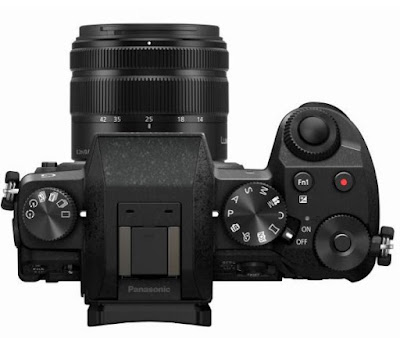2016 New About Panasonic G7 review
The Panasonic G1 was the world's first minimized framework camera (CSC), yet after a trailblazing begin this specific line of cameras sunk into a more practical corner. Different CSCs were littler, more good looking, speedier and – apparently – took better pictures. Indeed, even in this way, the thing we truly enjoyed about the Panasonic G6 was that it had no genuine shortcomings – on the off chance that you could pardon its dull appearance. It was responsive, it had exquisite controls, an enunciated touchscreen, an expansive electronic viewfinder and bunches of fun shooting modes. Picture quality wasn't a long ways behind the leaders and its video mode was among the best around. There's a great deal to be said for a camera that inconspicuously does its employment well, and the G6 was an uncommon case.Panasonic G7 review
 |
| Panasonic G7 review |
After two years we have the G7. In a few ways it has the same dependable, utilitarian soul as the G6. Nonetheless, the as good as ever elements make this an altogether more upmarket camera.
The most obvious change is the presentation of additional physical controls. The G6 had a solitary summon dial yet the G7 has two, giving direct access to screen velocity and gap in manual presentation mode. In need modes one dial can be set to give direct access to introduction remuneration. Then, squeezing one of two top-mounted catches allocates the dials to different capacities, and these can be modified in the menu.
There's additionally a committed dial to one side of the viewfinder for the drive mode, in addition to a switch for single auto, constant auto and manual core interest. The handgrip has been upgraded and feels more great and secure, particularly with a substantial lens joined.
 |
| 2016 New About Panasonic G7 review |
With such a large number of physical controls thus much degree for customisation, the G7 may appear to be excessively perplexing, however it needn't. It's simple just to overlook these controls and leave the camera in Auto mode. As prerequisites and certainty develop, having committed controls makes it much less demanding to get to holds with manual settings, both allegorically and truly.Panasonic G7
Another change to an effectively brilliant range is execution. The G6's self-adjust was responsive and solid however we observed the G7 to associate with twice as quick to center, with times somewhere around 0.1 and 0.4 seconds between squeezing the screen catch and catching a shot. Panasonic ascribes this to another innovation called Depth From Defocus (DFD), which just works with Panasonic lenses, however it has all the earmarks of being to a great degree powerful.
It added to a checked change in shot-to-shot times, rattling off three shots for each second in typical use. Changing to constant mode, it shot 101 JPEGs at a dumbfounding 8.3fps, or 6.1fps with persistent self-adjust. The recent is especially amazing, not minimum on the grounds that it to a great extent succeeded in following moving subjects at this pace. Having a physical single/persistent/manual center switch is a noteworthy reward here, as well. Crude persistent catch was at 6.7fps for 17 outlines, or 5.3fps for 19 outlines with ceaseless self-adjust, before easing back to 1.8fps. SLRs at this cost can't coordinate these paces or maintained execution.Panasonic G7
Different parts of the video mode are more than up to scratch. There's a shading profile called Cinelike D that delivers level, low-differentiation hues that are the perfect beginning stage for shading evaluating in programming. There's touchscreen control of the self-adjust point, following center and spot metering, in addition to manual control over shade speed, opening, ISO pace and amplifier volume level while recording.
There's no Cinema 4K (4,096x2,160) choice and no 1080p catch at high piece rates or at edge rates up to 96fps for moderate movement, as offered by Panasonic GH4, yet it's sufficiently reasonable that Panasonic continues something back for its leader model. These aren't huge gives up however. The G7 addresses the issues of sharp novice movie producers splendidly.Panasonic G7
It likewise incorporates the 4K Photo mode that shows up on the LX100 and different other Panasonic cameras. Every casing of 4K video is a 8-megapixel picture, and 4K Photo mode records 4K video at 30fps and permits individual edges to be spared as 8-megapixel JPEGs. There are alternatives to catch at 4:3, 3:2 and 1:1 viewpoint proportions and in addition the typical 16:9 utilized for video. The 8-megapixel picture is a product of the 16-megapixel sensor. This gives lenses a 2.6x harvest element – up from the standard 2x for Micro Four Thirds – which isn't so useful for wide-edge photography yet shouldn't be an issue for telephoto, for example, games and natural life.
On the G7 there are three twists on 4K Photo subject. One catches video for whatever length of time that the screen catch is squeezed, like a routine consistent mode. Another uses the screen catch as a record/respite catch for video catch. A third catches one second – 30 outlines – of video both previously, then after the fact the shade catch is squeezed. The last is perfect for catching brief activity where it's hard to respond rapidly enough. Picking which edges to spare as JPEGs is direct, with the capacity to look over the footage by swiping the touchscreen.Panasonic G7
Posst about 2016 New About Panasonic G7 review
Watch now Video a simple review about Panasonic G7
Comments
Post a Comment